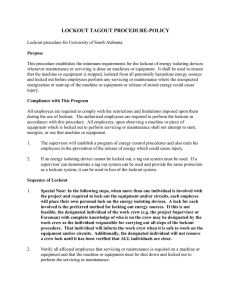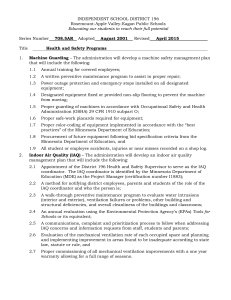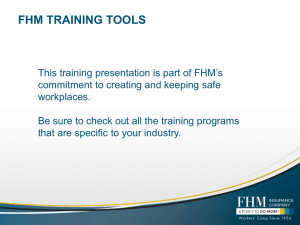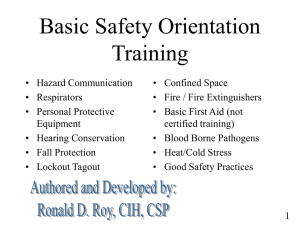Control of Hazardous Energy (Lockout/Tagout) Program
advertisement
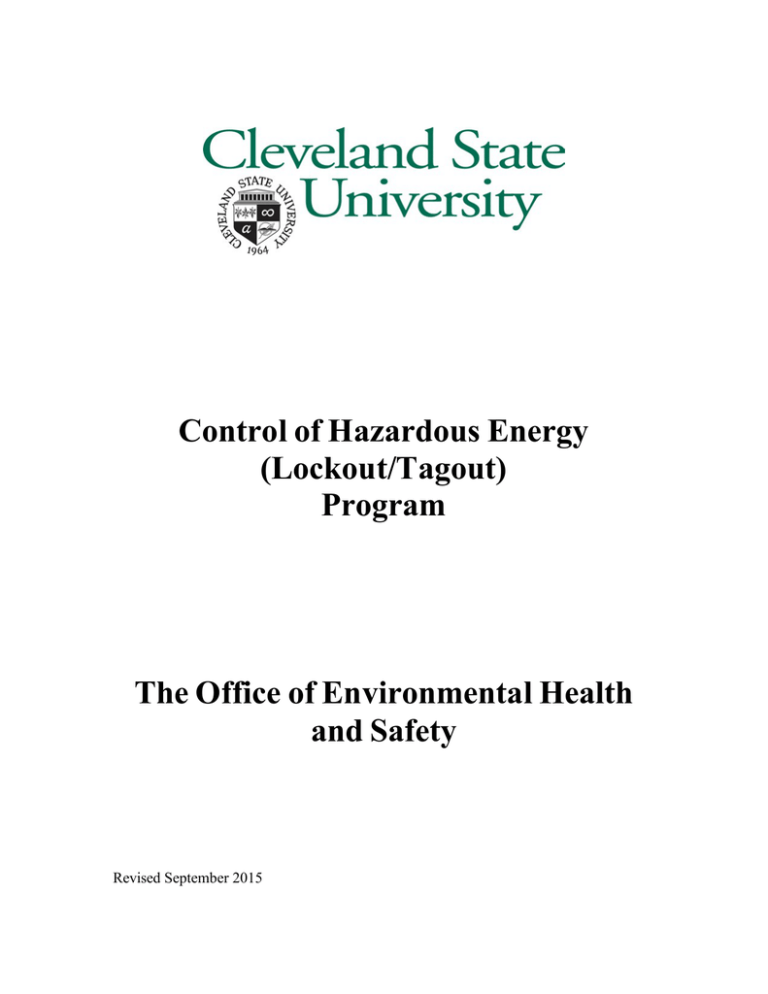
Control of Hazardous Energy (Lockout/Tagout) Program The Office of Environmental Health and Safety Revised September 2015 Table of Contents Purpose & Scope ............................................................................................ 3 Responsibilities............................................................................................... 3 Definitions .......................................................................................................... 4 Energy Control Program .............................................................................. 5 Application of Control .................................................................................. 6 Release from Lockout or Tagout ................................................................. 8 Lockout or Tagout Device Removal ............................................................ 8 Group Lockout or Tagout ............................................................................ 9 Personal Protective Equipment.................................................................... 9 Restoring Equipment to Service ................................................................ 10 Employee Training ...................................................................................... 10 Emergencies ................................................................................................. 10 Appendix A .................................................................................................. 11 Appendix B ................................................................................................... 12 2 Purpose & Scope Cleveland State University, in order to provide for a safe and healthy work environment, has developed this Lockout/Tagout program which describes the procedures for service and maintenance on equipment capable of generating hazardous energy. These procedures describe attaching an appropriate lockout or tagout devise on machines or equipment to prevent the unexpected energization or start-up of the machines or equipment or the release of stored up energy. This program is in compliance with Occupational Safety and Health Administration (OSHA) Standard 29 CFR 1910.147, The Control of Hazardous Energy (Lockout/Tagout), 29 CFR 1910.333, Selection and Use of Work Practices, and the National Fire Protection Association (NFPA) 70E. The OSHA Standards became applicable to instrumentalities of the State of Ohio in March, 1993, by action of the Ohio Legislature. This procedure applies at all times to the control of all potentially injurious energy sources such as, but not limited to: electrical, mechanical, hydraulic, pneumatic, chemical, thermal and gravitational. This Lockout/Tagout Program is applicable to all University employees, defined as a Cleveland State University faculty member, staff member, student worker, or contract employee who may be engaged in the service and/or maintenance of machines or equipment. The following list of topics is not covered by this program. 1. Installations under the exclusive control of electric utilities that generate, transmit, and distribute power, including related equipment of communication or metering. 2. Work on cord and plug connected electric equipment for which exposure to the hazards of unexpected energization or start-up of the equipment is controlled by the unplugging of the equipment from the energy source and by the plug being under the exclusive control of the employee performing the service or maintenance. 3. Hot tap operations involving transmission and distribution systems for substances such as gas, steam, water, or petroleum products when they are performed on pressurized pipelines, provided that it is demonstrated that: a. b. c. Continuity of service is essential. Shutdown of the system is impractical. Documented procedures are followed and special equipment is used that will provide proven protection for employees. Responsibilities The Cleveland State University Lockout/Tagout Program has been developed by the Office of Environmental Health & Safety, in conjunction with the Department of Utilities, Facilities Management. 3 Department Supervisors are to ensure that their employees who perform lockout/tagout procedures follow the procedures set forth in the Lockout/Tagout program of Cleveland State University. Each supervisor must insure that each new or transferred affected employee, contact employee and other employees whose work operations are or may be in the area, be aware of the purpose and use of the lockout/tagout procedure. Authorized employees are to adhere to the provisions and protocols set forth in the Lockout/Tagout Program, and are responsible for the proper application of these lockout/tagout procedures when performing the servicing and maintenance of machines and equipment. Authorized employees are to notify affected employees of their activities. Constant awareness of and respect for electrical hazards, and compliance with all safety rules is the responsibility of all employees. Definitions The following is a list of definitions for terms used in this program. Affected employee: An employee whose job requires him/her to operate or use a machine or equipment which servicing or maintenance is being performed under lockout or tagout, or whose job requires him/her to work in an area in which such servicing or maintenance is being performed. Authorized employee: An authorized employee is a person who is trained to lock out or tag out machines or equipment, in order to perform servicing or maintenance on that machine or equipment. An affected employee becomes an authorized employee when the employee's duties include performing, servicing or maintenance covered under this program. Capable of being locked out: An energy isolating device is capable of being locked out if it has a hasp or other means of attachment to or through which a lock can be affixed, or has a locking mechanism built into the device. Other energy isolating devices are capable of being locked out if lockout can be achieved without the need to dismantle, rebuild, or replace the energy isolating device or permanently alter its energy control capability. Employee: A Cleveland State University employee, or contract employee who may be engaged in the service and/or maintenance of machines or equipment. Energized: Electrically connected to an energy source containing residual or stored energy. Energy isolating device: A mechanical device that physically prevents the transmission or release of energy, including but not limited to the following: A manually operated electrical circuit breaker, a disconnect switch, a manually operated switch by which the conductors of a circuit can be disconnected from all ungrounded supply conductors. In addition, no pole can be operated independently; a line valve; a block; and any similar device used to block or isolate energy. Push buttons, selector switch, and other control devices are not energy isolating devices. 4 Energy source: Any source of electrical, mechanical hydraulic, pneumatic, chemical, thermal, or other energy. Hot tap: A procedure used in the repair, maintenance and services activities which involves welding on a piece of equipment (pipelines, vessels or tanks) under pressure to install connections or appurtenances. It is commonly used to replace or add sections of pipelines without the interruption of service for air, gas, water, steam, and petrochemical distribution systems. Lockout: The placement of a lockout device on an energy isolating device, in accordance with an established procedure, ensuring that the energy isolating device and the equipment being controlled cannot be operated until the lockout device is removed. Lockout device: A device that utilizes a positive means such as a lock, either key or combination type, to hold an energy isolating device in a safe position and prevent the energizing of a machine or equipment. Included are blank flanges and bolted slip blinds. Servicing and/or maintenance: Work place activities such as constructing, installing, setting up, adjusting, inspecting, modifying, and maintenance and/or servicing machines or equipment. These activities include lubrication, cleaning or unjamming of machines or equipment and making adjustments or tool changes, where the employee may be exposed to the unexpected energization or start-up of the equipment or release of hazardous energy. Tagout: The placement of a tagout device on an energy isolating device, in accordance with an established procedure, to indicate that the energy isolating device and the equipment being controlled may not be operated until the tagout device is removed. Tagout device: A prominent warning device, such as a tag and a means of attachment, which can be securely fastened to an energy isolating device in accordance with an established procedure to indicate that the energy isolating device and the equipment being controlled may not be operated until the tagout device is removed. Energy Control Program General Prior to an employee performing any servicing or maintenance on a machine or equipment where unexpected energizing, start up, or release of stored energy could occur, the machine or equipment shall be isolated from the energy source, and rendered inoperative. If a machine or equipment is not capable of being locked out, the energy control program shall utilize a tagout system. The energy control procedures shall include specific requirements for testing a machine or equipment to determine and verify the effectiveness of lockout devices, tagout devices, and other energy control measures. It is the policy of Cleveland State University to not permit work on any energized electrical lines where a mechanism for isolation exists. All employees must demonstrate 5 that no alternative option exists for required work to be performed without the line being energized. This process is to be facilitated only by the issuance of an Energized Work Permit (See Appendix A and B) upon evaluation of the work project by the Office of Environmental Health and Safety, and the Department of Utilities, Facilities Management. Lockout/Tagout If an energy isolating devise is capable of being locked out, the energy control program shall utilize lockout. Should it be determined that the device is physically unable to be locked out, a tagout system may be used provided it can be demonstrated that the utilization of a tagout system will provide full employee protection as described in the "Full Employee Section" below. Whenever replacement or major repair, renovation or modification of a machine or equipment is performed and whenever new machines or equipment are installed, assessments shall be made to provide for the modified equipment to accept a lockout device. All lockout/tagout devices or any type of protective materials and hardware shall be in accordance with 1910.147(c) (5). When a tagout device is used on an energy isolating device, the tagout device shall be attached at the same location that the lockout device would have been attached. The goal of the tagout process is to provide a level of safety equivalent to that obtained by using a lockout program. Additional steps to be considered as part of the tagout process will include implementing additional safety measures such as removing an isolating circuit element, blocking a controlling switch, opening an extra disconnecting device, or removing a valve handle to reduce the likelihood of inadvertent energization. Application of Control The lockout or tagout procedures shall cover the following elements and actions completed in the following sequence: 1. Before an authorized employee turns off a machine or equipment, the authorized employee shall know the type and magnitude of the energy, the hazards of the energy to be controlled, and the method or means to control the energy. 2. The authorized employee shall notify all affected personnel. 3. The machine or equipment shall be turned off or shut down using the procedures established for the machine or equipment. 4. All energy isolating devices that are needed to control the energy to the machine or equipment shall be physically located and operated in such a manner as to isolate the machine or equipment from the energy source(s). 6 5. When applying a lockout or tagout device, the employee shall observe the following guidelines: a. b. c. Lockout or tagout devices shall be affixed to each energy isolating device only by authorized employees. Lockout devices, where used, shall be affixed in a manner that will hold the energy isolating devices in a "safe" or "off" position. Tagout devices shall be affixed in a manner that will clearly indicate that the operation or movement of energy isolating devices from the "safe" or "off" position is prohibited. 1) Where tagout devices are used, the tag must be fastened at the same point at which the lock would be attached. 2) Should it not be physically capable of affixing a tag directly to the energy isolating device, the tag shall be located as close as safely possible to the device in a position that will be immediately obvious to anyone attempting to operate the device. 3) When a tag is attached to an energy isolating means, it is not to be removed without authorization of the authorized person responsible for it and it is never to be bypassed, ignored, or otherwise defeated. 4) Information placed on the tag must be legible to all other employees involved in the project 6. Following the application of lockout or tagout devices to energy isolating devices, all potentially hazardous stored or residual energy shall be relieved, disconnected, restrained, and otherwise rendered safe. NOTE: If there is a possibility of re-accumulation of stored energy to a hazardous level, verification of isolation must be continued until the servicing or maintenance is completed or until the possibility of such accumulation no longer exists. 7. Prior to starting work on machines or equipment that have been locked out or tagged out; the authorized employee must verify that isolation and deenergization of the machine or equipment have been accomplished. 8. Return the equipment to service. 7 Release from Lockout or Tagout Before lockout or tagout devices are removed and energy is restored to the machine or equipment, procedures shall be followed and actions taken by the authorized employee(s) to ensure the following: 1. The work area shall be inspected to ensure that nonessential items have been removed and to ensure that machine or equipment components are operationally intact. 2. Employees must be notified as to the current lockout or tagout condition. a. b. c. The work area must be checked to ensure that all employees have been safely positioned or removed. Before lockout or tagout devices are moved and before machines or equipment are energized, affected employees shall be notified that the lockout or tagout devices will be removed. After lockout or tagout devices have been removed and before a machine or equipment is started, affected employees shall be notified that the lockout or tagout device(s) have been removed. Lockout or Tagout Devices Removal Each lockout or tagout device must be removed from any energy isolating device by the employee who applied the device. Additional Requirements 1. In situations in which lockout or tagout devices must be temporarily removed from the energy isolating device and the machine or equipment energized to test or position the machine, equipment or component thereof, employees shall observe the following sequence of actions: a. b. c. d. e. 2. Clear the machine or equipment of tools and materials. Remove employees from the machine or equipment area. Remove the lockout or tagout devices. Energize and proceed with testing or positioning. De-energize all systems and reapply energy control measures according to the "Application of Control" section of this program to continue the servicing and/or maintenance. Whenever outside servicing personnel are to be engaged in activities covered by the scope and application of this program, Cleveland State University and the outside employer shall inform each other of their respective lockout or tagout procedures. The department supervisor affected by the contractor's lockout/tagout procedures will ensure that its employees understand and comply with the restrictions and prohibitions of the outside employer's energy control program. 8 3. In work situations where shift or personnel changes occur, specific procedures shall be utilized to ensure the continuity of lockout or tagout protection. This includes an orderly transfer of lockout or tagout device protection between offgoing and oncoming employees to minimize exposure to hazards from the unexpected energization or start-up of the machine or equipment or the release of stored energy. Group Lockout or Tagout 1. When servicing and/or maintenance is performed by a crew, craft, department or other group, they shall utilize a procedure which affords the employees a level of protection equivalent to that provided by the implementation of a personal lockout or tagout device. No employee may perform work under another employees lock. 2. Group lockout or tagout devices shall follow protocols established in the "Energy Control Program" section of this program. 3. In addition to the Energy Program requirements, the following guidelines also apply: a. When more than one crew, craft, department, etc. is involved, an assignment of overall job-associated lockout or tagout control responsibilities shall be made to an authorized employee designed to coordinate affected work forces and ensure continuity of protection. b. Primary responsibility lies with the authorized employee coordinator working under the protection of a group lockout or tagout device. c. The authorized employee coordinator must ascertain the exposure status of individual group members with regard to the lockout or tagout of the machine or equipment. d. Each authorized employee shall affix a personal lockout or tagout device to the group lockout device, group lockbox, or comparable mechanism when he or she begins work and shall remove those devices when he or she stops working on the machine or equipment being serviced or maintained. Retraining shall be provided for all employees whenever there is a change in their job assignments, a change in machines, equipment or processes that present a new hazard, or when there is a change in the energy control procedures. Personal Protective Equipment Personal protective equipment (PPE) appropriate for use with electrical hazards will be provided to employees as recommended by National Fire Protection Association ( N F P A ) 70E – 2015. 9 Restoring Equipment to Service When the servicing or maintenance is completed and the machine or equipment is ready to return to normal operating condition, the following steps should be taken. (1) Check the machine or equipment and the immediate area around the machine or equipment to ensure that nonessential items have been removed and that the machine or equipment components are operationally intact and guards replaced. (2) Check the work area to ensure that all employees have been safely positioned or removed from the area. (3) Verify that the controls are in neutral. (4) Remove the lockout devices and re-energize the machine or equipment. NOTE: The removal of some forms of blocking may require re-energization of the machine before safe removal. (5) Notify affected employees that the servicing or maintenance is completed and the machine or equipment is ready for use. Employee Training Training shall be provided to applicable employees to ensure that the purpose and function of the energy control program are understood and to provide the knowledge and skills for the safe application, usage, knowledge and removal of the energy controls. The training shall include: *purpose and use of the energy control procedure. *the recognition of applicable hazardous energy sources, the type and magnitude of the energy available in the work place, and the methods and means necessary for energy isolation and control. *Lockout/tagout process *the prohibition relating to attempts to restart or re-energize machines or equipment which are locked out or tagged out Emergencies Dial 9-1-1 or 8, 9-1-1 for any campus emergency. Cell phone users are to also Dial 9-1-1 and tell the operator to connect you to CSU Police. 10 Appendix A EWP#CSUCleveland State University Office of Environmental Health & Safety CSU Employee Energized Work Permit EMERGENCY CALL 911 FROM A CAMPUS PHONE. NON- EMERGENCY x 2020. CELL PHONE USERS WHO DIAL 911 INFORM DISPATCHER TO CONNECT YOU TO C.S.U. POLICE DEPARTMENT. CSU Employees intending to perform energized work (defined as any work process or task on electrical lines that have not been de-energized)) are to fill out this form completely, and bring to the Department of Utilities (Plant Services Building) for evaluation prior to starting work. A signed permit is required prior to performing any energized work.. NOTE: Permit shall expire twenty-four (24) hours following the start time indicated. Additional permit(s) are required for work to continue beyond this period. Date of Work: Responsible Person: Work to be performed: Building: If CSU employee, indicate Department: Start Time: Room Number/Area: Justification for Request to Perform Energized Work: Check the items applicable to the job/project: *Equipment to be used has been inspected and is in good operating condition □ *Workers have proper personal protective equipment to safely perform work □ I affirm that the above precautions have been taken Person responsible for Energized Work Approved Date CSU Utilities Department 11 *Life Safety Systems (Sprinklers, Smoke Alarms) are operational and will not be taken out of service during work □ I affirm that the above precautions have been taken Person responsible for Energized Work Approved Date CSU Utilities Department 12 Appendix B EWP#OCCleveland State University Office of Environmental Health & Safety Contracted Employee (Non-University) Energized Work Permit EMERGENCY CALL 911 FROM A CAMPUS PHONE. NON-EMERGENCY x2020 CELL PHONE USERS WHO DIAL 911 INFORM DISPATCHER TO CONNECT YOU TO C.S.U. POLICE DEPARTMENT. CSU Employees intending to perform energized work (defined as any work process or task on electrical lines that have not been de-energized)) are to fill out this form completely, and bring to the Department of Utilities (Plant Services Building) for evaluation prior to starting work. A signed permit is required prior to performing any energized work... NOTE: Permit shall expire twenty-four (24) hours following the start time indicated. Additional permit(s) are required for work to continue beyond this period. Date of Work: Responsible Person: Work to be performed: Building: If CSU employee, indicate Department: Start Time: Room Number/Area: Justification for Request to Perform Energized Work: Check the items applicable to the job/project: *Equipment to be used has been inspected and is in good operating condition □ *Workers have proper personal protective equipment to safely perform work □ I affirm that the above precautions have been taken Person responsible for Energized Work Approved Date CSU Utilities Department 13 *Life Safety Systems (Sprinklers, Smoke Alarms) are operational and will not be taken out of service during work □ I affirm that the above precautions have been taken Person responsible for Energized Work Approved Date CSU Utilities Department 14
